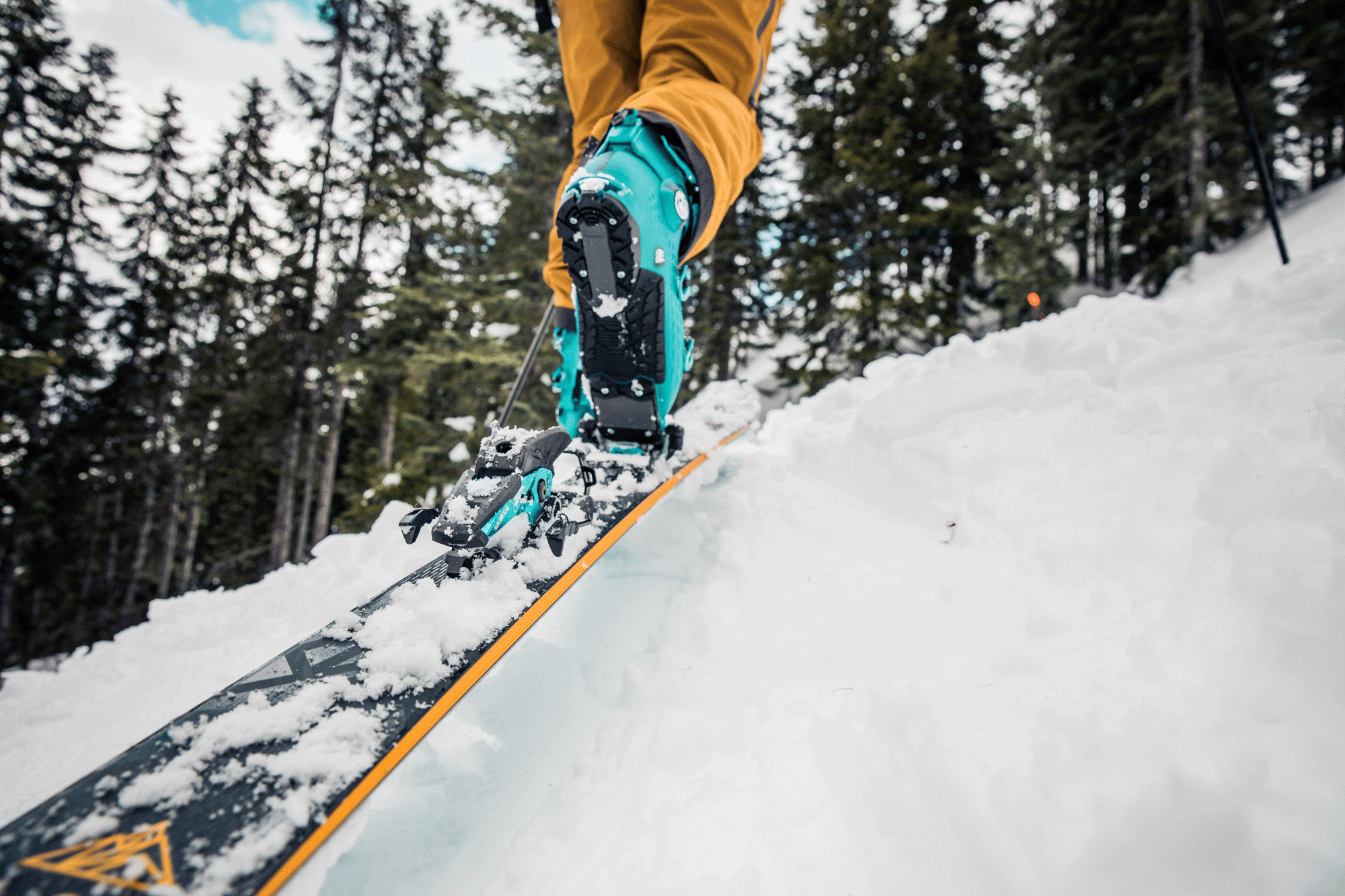These days, there is an alpine touring (AT) binding for every type of backcountry skier, including those who want one binding that does it all. Whether you’re an experienced backcountry skier or you’re just beginning to venture out-of-bounds, here are our tips for how to choose the right AT bindings, along with the information you need to select between our favorite bindings of the season: the Marker Duke Pro EPF 18, Marker Kingpin 13, Dynafit ST Rotation 12, G3 Ion 12 and Salomon S/LAB Shift MNC.
Note: Before heading into the backcountry, you should seek avalanche training from experts in the field. To get started, read the REI Expert Advice series of articles starting with Avalanche Basics, and then sign up for a class.
Breaking Down Alpine Touring Bindings
Similar to traditional downhill bindings, AT bindings have a few major elements you should understand before buying:
- Release range: This is the measure of force it takes to release your boots from your bindings.
- Weight: The amount of weight you’re toting uphill quickly becomes a factor when touring. The farther you want to go, the lighter the bindings you’ll want to invest in.
- Heel risers: Heel risers, or climbing bars, make going up steep hills easier by decreasing calf fatigue. Most AT bindings have one or two riser heights for different degrees of incline.
- Brakes: Brakes prevent your skis from flying downhill when your bindings release from your boots. You can get AT bindings with or without brakes, and there are pros and cons to both. Brakes keep your skis nearby (theoretically) when you fall or when you’re clicking in or out, but they weigh more. AT bindings without brakes come with leashes that attach to your boots. Those leashes can increase risk in a crash or avalanche, but the bindings tend to be lighter weight.
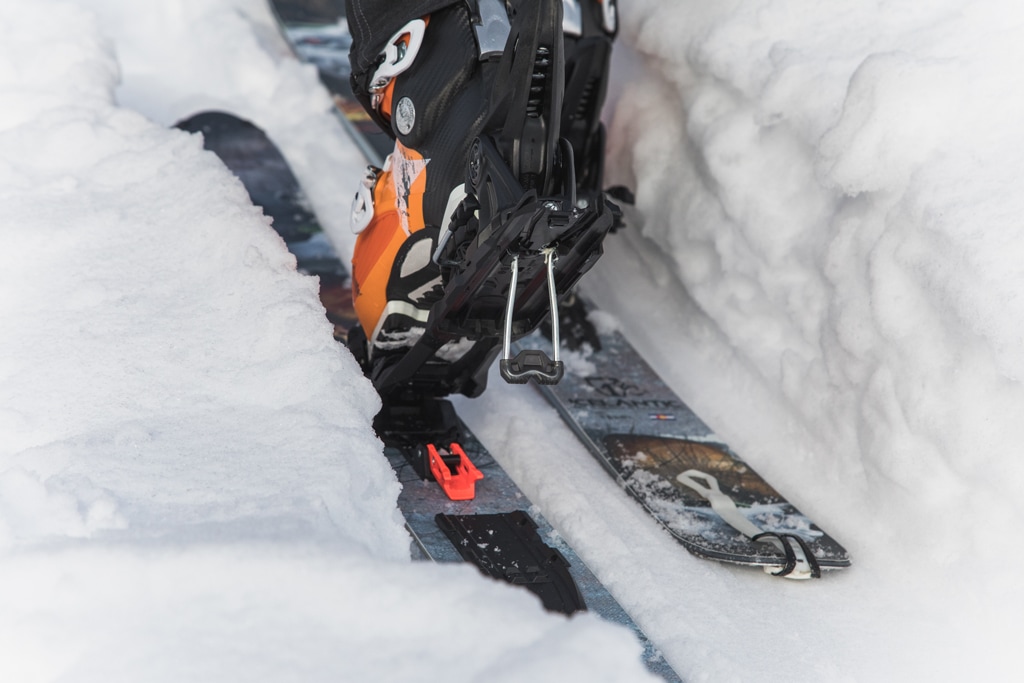
Heel risers, or climbing bars, help decrease calf fatigue when you’re climbing uphill. Most touring bindings come with one or two riser heights.
More Factors to Consider:
- Where do you plan to ski, and what type of skiing do you plan to do? Will you spend most of your time skiing in-bounds with the occasional hut trip or tour? Are you an avid backcountry skier looking for a setup that will allow you to log more miles in a single outing? Or, are you somewhere in between? “The more time you’re planning on spending going uphill, the lighter and more efficient a binding you’ll want,” said Emily Murray, an assistant category merchant for snowsports at REI.
- What is your body type, weight and ability level? More aggressive skiers will want a binding with a higher release setting to prevent unwanted ejections.
- What skis do you plan to mount the AT bindings on? According to Murray, you should mount lightweight bindings on lightweight skis, and heavy bindings on heavier skis. “Lightweight bindings will not be able to successfully power a heavy, more alpine-oriented ski,” Murray said. “They’re not designed to, and that’s okay.”
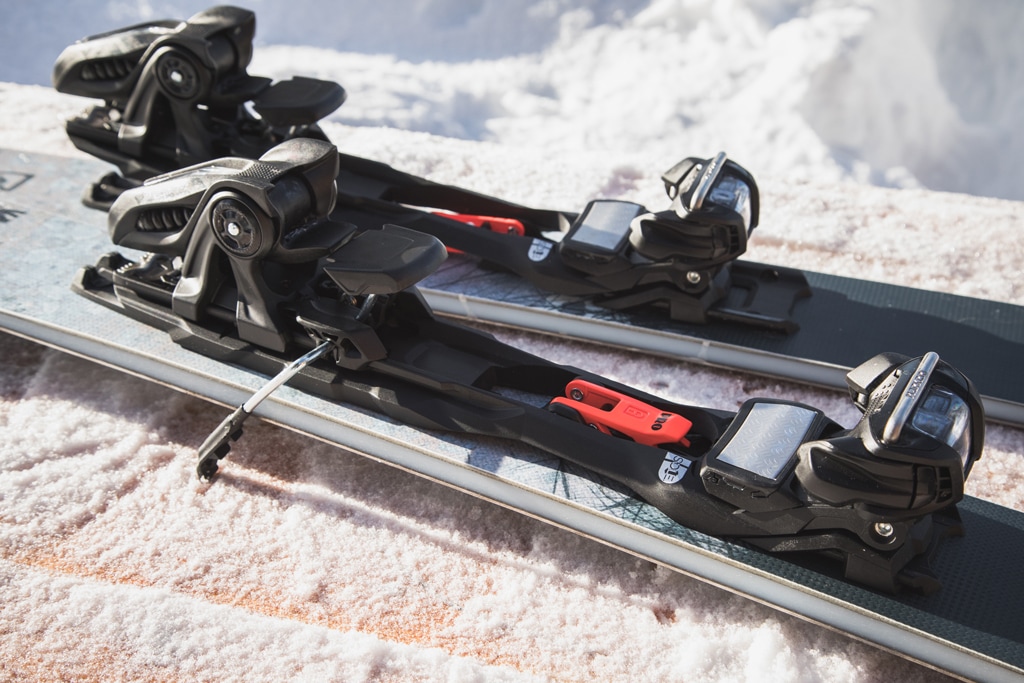
Think about mounting lightweight bindings on lightweight skis, and heavy bindings, like the Marker Duke Pro EPF 18, on heavier skis.
Once you’ve decided where you plan to ski and which skis you plan to mount your bindings on, consider the boots you’ll use. There are two primary types of touring bindings: frame and tech. We’ll get into boot/binding compatibility, but it’s important to know that not all boots work with every binding.
Matching Bindings to Boots
Alpine touring boot and binding compatibility is a complicated, ever-changing landscape. Certifications exist to help you determine which boots and bindings play well together, but there are always exceptions, modifications and adapters. According to Murray: “Boots are far and away the most complicated and specific bit of the puzzle. Ideally, you should pick bindings that work with boots you already own instead of buying bindings and then getting boots later.” Finding the correct boot fit for you can be more difficult than finding the right bindings, so start there first.
Tech bindings are comprised of separate toe and heel pieces that use pins to hold your ski boots in place when you’re touring uphill and skiing down. They require tech-specific boots or boots with inserts that feature molded toes and heels with slots in order to lock into the binding. Frame bindings are like traditional downhill ski bindings, but they have a rail that lifts away from your skis when in touring mode. They are compatible with most traditional alpine and AT boots.
The trade-off between tech and frame bindings is generally weight and performance: Tech bindings tend to be lighter weight and more efficient because they have a separate toe and heel piece. Some may find that frame bindings perform better on the downhill because there is a larger point of contact between your ski boots and bindings, letting you transfer more power from your legs to your skis. Murray adds: “A downhill toe is more elastic, allowing for more movement before releasing and absorbing more chatter from the snow’s surface.”

A tech binding close-up: The G3 Ion 12 bindings have a user-friendly heel that can be turned clockwise or counterclockwise for skinning.
Some, but certainly not all, tech bindings are certified by TÜV, an independent safety monitoring agency that tests the DIN ISO (International Standards Organization) standard for safety release. This means that TÜV-certified AT bindings will release with the same amount of force as downhill ski bindings with the same DIN setting. Translation? Get a tech binding certified by TÜV and you don’t have to worry about your bindings not releasing during a fall.
“In the past three to four years, AT bindings with a DIN-releasable tech toe have become the standard for midweight tech bindings rather than the exception,” Murray said. Most, but not all frame bindings use the same DIN standards as traditional downhill ski bindings.
The shape of the soles of traditional downhill ski boots are defined by the standard ISO 5355, and are compatible with downhill bindings defined by ISO 9462. The shape of many AT boots, ISO 9523, is not compatible with most downhill bindings. There are also two newer AT sole types, Walk to Ride (WTR) and GripWalk, which have rockered traction soles. These soles are not defined by ISO/DIN standards, and each is compatible with a different variety of bindings.
Ski boot sole standards include:
- ISO/DIN 5355: Most downhill ski boots, compatible with most AT frame bindings
- Walk to Ride (WTR): Proprietary rockered soles compatible with WTR or Multi-Norm Certified (MNC) bindings
- GripWalk: Proprietary rockered soles compatible with most WTR, MNC and GripWalk certified bindings
- AT-specific soles:
- ISO/DIN 9523-compliant: Rockered soles compatible with most AT bindings
- ISO/DIN 9523-non-compliant: Compatible with tech bindings only
As you can see, boot/binding compatibility gets complicated quickly. Your best bet is to talk with your local shop or boot fitter and confirm that your setup is compatible and will function properly.
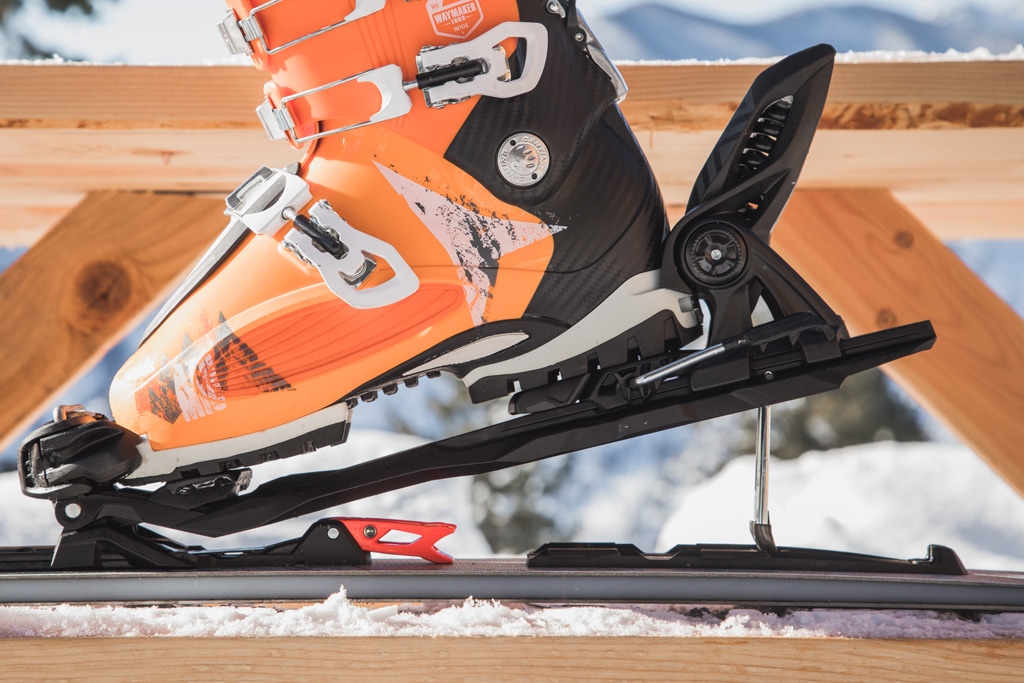
The only frame bindings in this guide, the Marker Duke EPF Pro 18 are compatible with most ISO 5355, ISO 9523-compliant, Walk to Ride (WTR) and GripWalk boots.
Most of the bindings in this guide are tech, meaning they can only be paired with tech boots. The Marker Duke frame bindings are compatible with most ISO 5355, ISO 9523-compliant, Walk to Ride (WTR) and GripWalk boots. The Salomon Shift is a unique tech binding and likely heralds the future of AT design, because it has both the pins of a tech binding and a full downhill toe.
Comparing Alpine Touring Binding Capabilities
Once you’ve identified what you need from AT bindings, you can narrow down what you’re looking for.
The only frame binding on our list, the Marker Duke Pro EPF 18 is built for touring but excels on the downhill. According to Murray, the Duke is designed to be mounted on a traditional alpine ski as it skis like an alpine binding, thanks to a DIN range of 8–18 and robust toe and heel pieces that transfer power efficiently. The transition from touring to downhill mode isn’t the fastest, but it’s a great binding if your goals include hitting big lines and catching air.
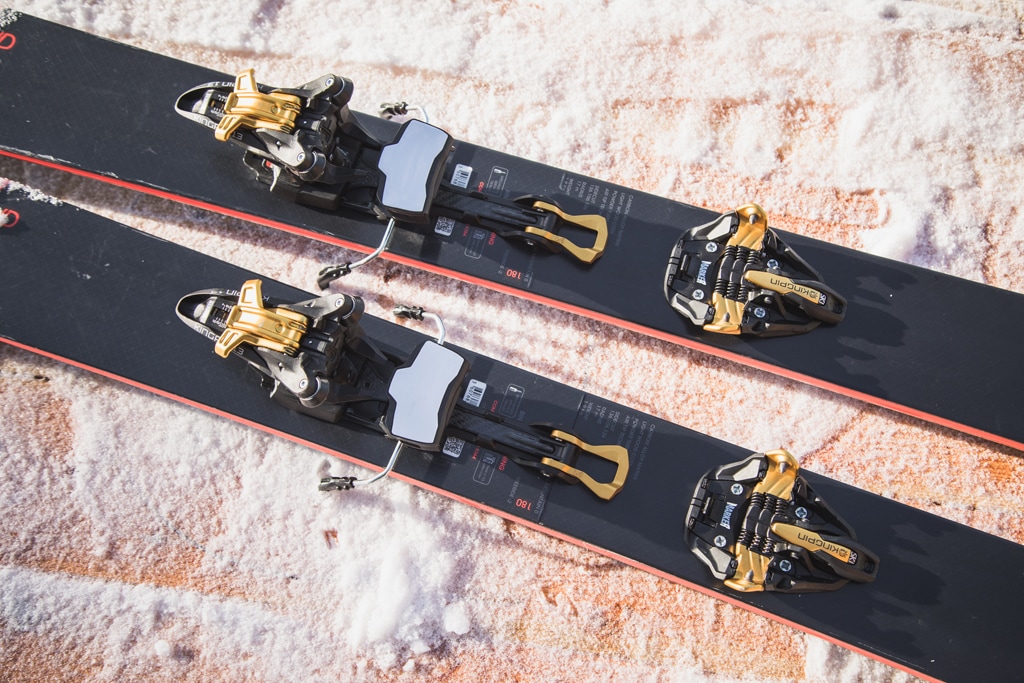
If you plan to ski aggressively downhill but prefer a tech binding over a frame, the Marker Kingpin 13 could be right for you
The Marker Kingpin 13 was the first tech binding to receive an ISO/DIN rating from TÜV, with a DIN range of 6–13. If you plan to ski aggressively downhill but prefer a tech binding over a frame, these are for you. The pin-style toe makes skinning smooth and comfortable. The Kingpin balances weight and performance, with exceptional energy transfer thanks to the heel piece that forgoes the usual pin-tech fitting for a more downhill-style retention system with a spring-loaded lever that has more contact area with your boots. They work well with wider skis, but might need adapters to pair with your tech boots.
The Dynafit ST Rotation 12 tech bindings are designed to enable heavier and more aggressive skiers ride big lines with confidence, and the bindings are TÜV-certified for a DIN range of 6–12. This is thanks to a rotating toe piece from which the binding gets its name, and spring-loaded heel units that help mitigate sudden impacts and decrease the chance of prerelease. Lighter than the Kingpin, the Rotation’s design is compatible with nearly all tech boots.

A TÜV-certified rotating toe piece helps prevent unintended releases on the on the Dynafit ST Rotation 12.
The G3 Ion 12 has earned a few awards, including Editor’s Choice from Backcountry magazine. These bindings are easy to use, have strong downhill performance and come with brakes, making them a perfect choice for those looking to get into touring, as well as experienced backcountry skiers who want to feel comfortable whether they’re climbing or descending.
The Salomon S/LAB Shift MNC is unique in that it switches from a tech to an alpine binding with the push of a button, and it performs well in both touring and ski modes. If you split your time between the resort and the skin track, the Shift could be your do-it-all workhorse. (One caveat: They have just one height of heel riser, whereas all the other bindings here have two.) Check out our full review here.
One-Quiver Ski Bindings and the Future of AT
According to Murray, “For the past decade, the industry has been trying to develop a binding that allows the user to travel uphill without sacrificing downhill performance.” All that changed in 2018 with the Salomon S/Lab Shift. In addition to being compatible with tech boots, the Shift can also fit most ISO 5355, ISO 9523-compliant, Walk to Ride (WTR) and GripWalk boots.
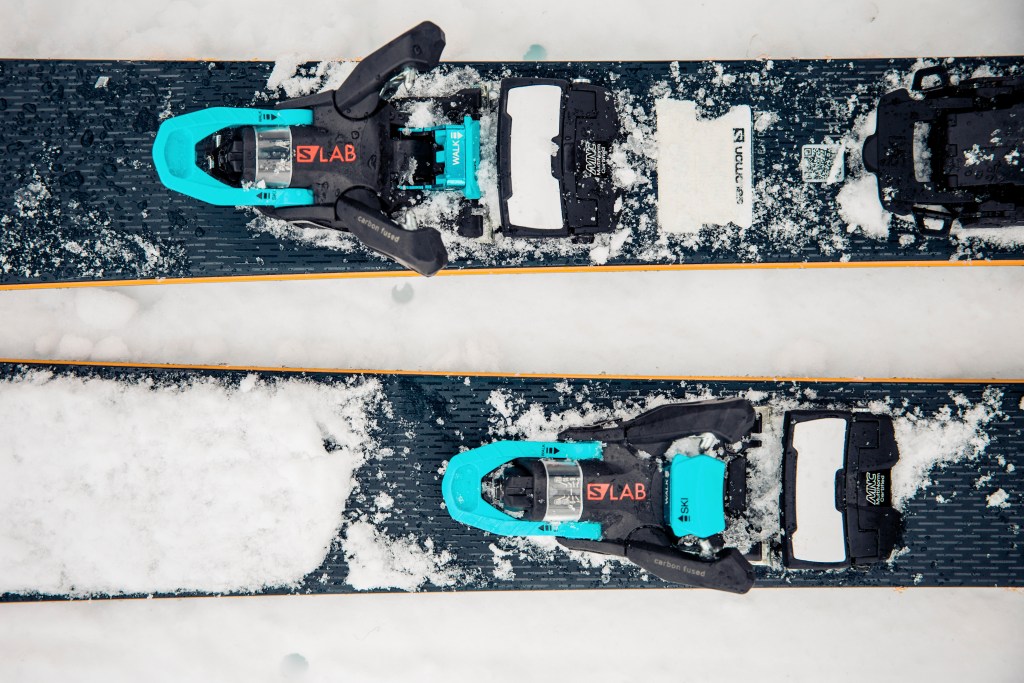
On the S/Lab Shift, the toe piece converts from a conventional toe in ski mode to a pinned tech toe for skinning.
The toe of the Shift changes at the click of a lever from having a traditional downhill toe for ski mode to having pins for touring mode. It also absorbs vibration caused by skiing over hard, crunchy snow. This adds to its resort performance, where you’re more likely to ski variable snow conditions.
The Shift has made a big impact on the industry. Boot manufacturers are seeing the need to have Shift-compatible soles, and other binding brands will likely release their own “quiver killer” bindings in the near future.
Which Alpine Touring Ski Bindings Are Best for You?
Taking into consideration all of the above, which alpine touring ski bindings should you get?
1. Marker Duke Pro EPF 18 Bindings
Choose the Marker Duke Pro EPF 18 bindings if you’re a more aggressive skier who ventures into the backcountry looking for big lines, steep terrain or huge air. These are right if the weight of your bindings isn’t a big consideration for you and your touring is focused more on going down rather than up. Looking for a similar binding with a lower DIN range? Consider the Marker Baron 13 EPF.
2. Marker Kingpin 13 Bindings
Choose the Marker Kingpin 13 if you need a good balance of up and downhill performance and prefer the efficiency of a tech binding. The combination of the pin-style toe and spring-loaded heel offer the best of both worlds.
3. Dynafit ST Rotation 12 Bindings
Choose the Dynafit ST Rotation 12 if you want bindings that transition so easily you don’t need to take your skis off. While not the best in variable snow conditions, you’ll love it on the skin track and in powder.
4. G3 Ion 12 Bindings
Choose the G3 Ion 12 if you want a user-friendly, well-rounded backcountry touring binding that lets you ski a little harder than some other tech bindings. The toe pieces are easy to step into, but you do have to take the skis off to transition between modes.
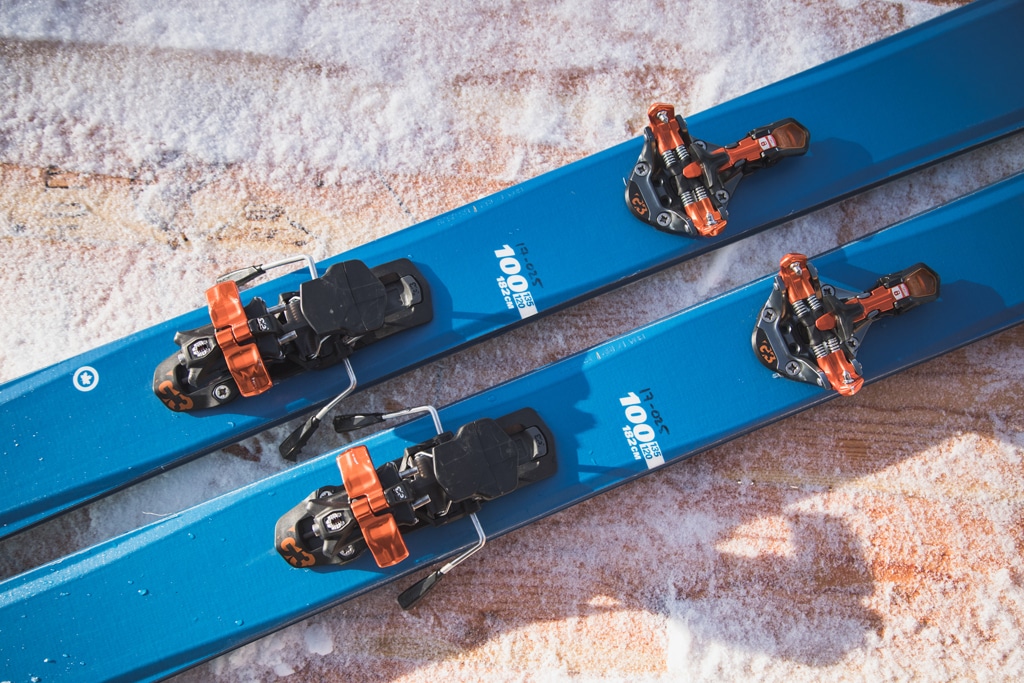
A detail shot of the G3 Ion 12 bindings.
5. Salomon S/LAB Shift MNC Bindings
Choose the Salomon S/LAB Shift MNC bindings if you want to split your time between the resort and the backcountry without changing setups. They aren’t the lightest, but they’ll perform well in both environments, giving you great bang for your buck.
Alpine touring ski binding specs at a glance:
| Binding | Binding Type | Weight (Pair) | Release Value | Heel Risers | Brake Width (mm) |
| Salomon S/Lab Shift MNC | Tech | 3 lbs. 12 oz. | 6-13 | 1 | 90, 100, 110, 120 |
| Dynafit ST Rotation 12 | Tech | 2 lbs. 10.2 oz | 6-12 | 2 | 90, 105, 120, 135 |
| G3 Ion 12 | Tech | 2 lbs. 10 oz. | 5-12 | 2 | 85, 100, 115, 130 |
| Marker Kingpin 13 | Tech | 3 lbs. 6.2 oz. | 6-13 | 2 | 75-100; 100-125 |
| Marker Duke Pro EPF 18 | Frame | 6 lbs. 2.4 oz. | 8-18 | 2 | 110 |
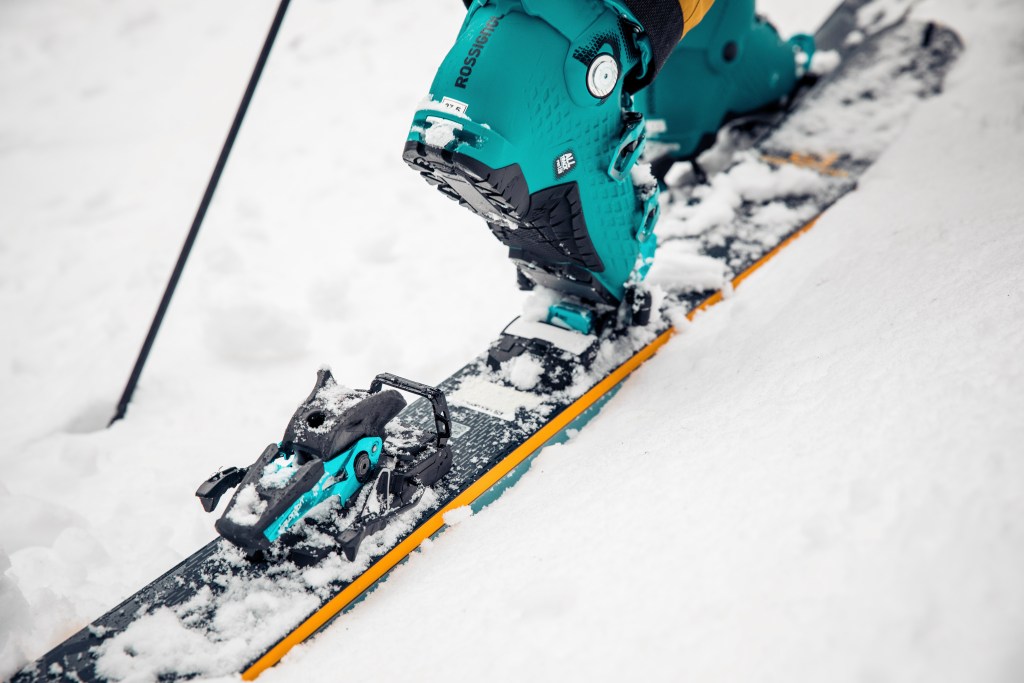
Skinning uphill in the Salomon S/Lab Shift.
Lastly, a reminder: No matter which bindings match your needs, traveling in the backcountry requires avalanche training and the proper safety equipment, including a shovel, beacon and probe. Read more about backcountry safety and avalanche awareness here.
